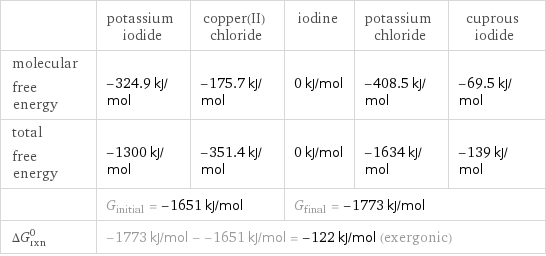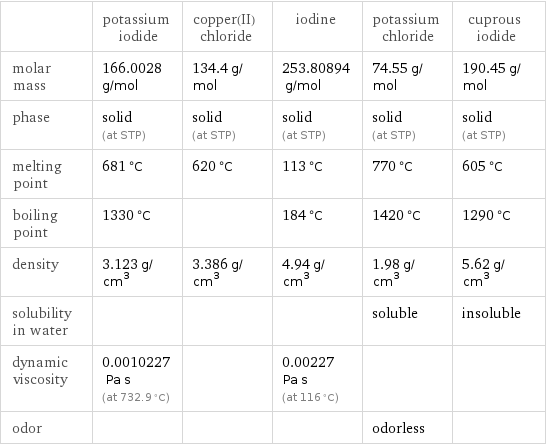Input interpretation

KI (potassium iodide) + CuCl_2 (copper(II) chloride) ⟶ I_2 (iodine) + KCl (potassium chloride) + CuI (cuprous iodide)
Balanced equation

Balance the chemical equation algebraically: KI + CuCl_2 ⟶ I_2 + KCl + CuI Add stoichiometric coefficients, c_i, to the reactants and products: c_1 KI + c_2 CuCl_2 ⟶ c_3 I_2 + c_4 KCl + c_5 CuI Set the number of atoms in the reactants equal to the number of atoms in the products for I, K, Cl and Cu: I: | c_1 = 2 c_3 + c_5 K: | c_1 = c_4 Cl: | 2 c_2 = c_4 Cu: | c_2 = c_5 Since the coefficients are relative quantities and underdetermined, choose a coefficient to set arbitrarily. To keep the coefficients small, the arbitrary value is ordinarily one. For instance, set c_3 = 1 and solve the system of equations for the remaining coefficients: c_1 = 4 c_2 = 2 c_3 = 1 c_4 = 4 c_5 = 2 Substitute the coefficients into the chemical reaction to obtain the balanced equation: Answer: | | 4 KI + 2 CuCl_2 ⟶ I_2 + 4 KCl + 2 CuI
Structures

+ ⟶ + +
Names

potassium iodide + copper(II) chloride ⟶ iodine + potassium chloride + cuprous iodide
Reaction thermodynamics
Enthalpy

| potassium iodide | copper(II) chloride | iodine | potassium chloride | cuprous iodide molecular enthalpy | -327.9 kJ/mol | -220.1 kJ/mol | 0 kJ/mol | -436.5 kJ/mol | -67.8 kJ/mol total enthalpy | -1312 kJ/mol | -440.2 kJ/mol | 0 kJ/mol | -1746 kJ/mol | -135.6 kJ/mol | H_initial = -1752 kJ/mol | | H_final = -1882 kJ/mol | | ΔH_rxn^0 | -1882 kJ/mol - -1752 kJ/mol = -129.8 kJ/mol (exothermic) | | | |
Gibbs free energy

| potassium iodide | copper(II) chloride | iodine | potassium chloride | cuprous iodide molecular free energy | -324.9 kJ/mol | -175.7 kJ/mol | 0 kJ/mol | -408.5 kJ/mol | -69.5 kJ/mol total free energy | -1300 kJ/mol | -351.4 kJ/mol | 0 kJ/mol | -1634 kJ/mol | -139 kJ/mol | G_initial = -1651 kJ/mol | | G_final = -1773 kJ/mol | | ΔG_rxn^0 | -1773 kJ/mol - -1651 kJ/mol = -122 kJ/mol (exergonic) | | | |
Equilibrium constant
![Construct the equilibrium constant, K, expression for: KI + CuCl_2 ⟶ I_2 + KCl + CuI Plan: • Balance the chemical equation. • Determine the stoichiometric numbers. • Assemble the activity expression for each chemical species. • Use the activity expressions to build the equilibrium constant expression. Write the balanced chemical equation: 4 KI + 2 CuCl_2 ⟶ I_2 + 4 KCl + 2 CuI Assign stoichiometric numbers, ν_i, using the stoichiometric coefficients, c_i, from the balanced chemical equation in the following manner: ν_i = -c_i for reactants and ν_i = c_i for products: chemical species | c_i | ν_i KI | 4 | -4 CuCl_2 | 2 | -2 I_2 | 1 | 1 KCl | 4 | 4 CuI | 2 | 2 Assemble the activity expressions accounting for the state of matter and ν_i: chemical species | c_i | ν_i | activity expression KI | 4 | -4 | ([KI])^(-4) CuCl_2 | 2 | -2 | ([CuCl2])^(-2) I_2 | 1 | 1 | [I2] KCl | 4 | 4 | ([KCl])^4 CuI | 2 | 2 | ([CuI])^2 The equilibrium constant symbol in the concentration basis is: K_c Mulitply the activity expressions to arrive at the K_c expression: Answer: | | K_c = ([KI])^(-4) ([CuCl2])^(-2) [I2] ([KCl])^4 ([CuI])^2 = ([I2] ([KCl])^4 ([CuI])^2)/(([KI])^4 ([CuCl2])^2)](../image_source/fc352ecfea5356c401ab04804eba1e4c.png)
Construct the equilibrium constant, K, expression for: KI + CuCl_2 ⟶ I_2 + KCl + CuI Plan: • Balance the chemical equation. • Determine the stoichiometric numbers. • Assemble the activity expression for each chemical species. • Use the activity expressions to build the equilibrium constant expression. Write the balanced chemical equation: 4 KI + 2 CuCl_2 ⟶ I_2 + 4 KCl + 2 CuI Assign stoichiometric numbers, ν_i, using the stoichiometric coefficients, c_i, from the balanced chemical equation in the following manner: ν_i = -c_i for reactants and ν_i = c_i for products: chemical species | c_i | ν_i KI | 4 | -4 CuCl_2 | 2 | -2 I_2 | 1 | 1 KCl | 4 | 4 CuI | 2 | 2 Assemble the activity expressions accounting for the state of matter and ν_i: chemical species | c_i | ν_i | activity expression KI | 4 | -4 | ([KI])^(-4) CuCl_2 | 2 | -2 | ([CuCl2])^(-2) I_2 | 1 | 1 | [I2] KCl | 4 | 4 | ([KCl])^4 CuI | 2 | 2 | ([CuI])^2 The equilibrium constant symbol in the concentration basis is: K_c Mulitply the activity expressions to arrive at the K_c expression: Answer: | | K_c = ([KI])^(-4) ([CuCl2])^(-2) [I2] ([KCl])^4 ([CuI])^2 = ([I2] ([KCl])^4 ([CuI])^2)/(([KI])^4 ([CuCl2])^2)
Rate of reaction
![Construct the rate of reaction expression for: KI + CuCl_2 ⟶ I_2 + KCl + CuI Plan: • Balance the chemical equation. • Determine the stoichiometric numbers. • Assemble the rate term for each chemical species. • Write the rate of reaction expression. Write the balanced chemical equation: 4 KI + 2 CuCl_2 ⟶ I_2 + 4 KCl + 2 CuI Assign stoichiometric numbers, ν_i, using the stoichiometric coefficients, c_i, from the balanced chemical equation in the following manner: ν_i = -c_i for reactants and ν_i = c_i for products: chemical species | c_i | ν_i KI | 4 | -4 CuCl_2 | 2 | -2 I_2 | 1 | 1 KCl | 4 | 4 CuI | 2 | 2 The rate term for each chemical species, B_i, is 1/ν_i(Δ[B_i])/(Δt) where [B_i] is the amount concentration and t is time: chemical species | c_i | ν_i | rate term KI | 4 | -4 | -1/4 (Δ[KI])/(Δt) CuCl_2 | 2 | -2 | -1/2 (Δ[CuCl2])/(Δt) I_2 | 1 | 1 | (Δ[I2])/(Δt) KCl | 4 | 4 | 1/4 (Δ[KCl])/(Δt) CuI | 2 | 2 | 1/2 (Δ[CuI])/(Δt) (for infinitesimal rate of change, replace Δ with d) Set the rate terms equal to each other to arrive at the rate expression: Answer: | | rate = -1/4 (Δ[KI])/(Δt) = -1/2 (Δ[CuCl2])/(Δt) = (Δ[I2])/(Δt) = 1/4 (Δ[KCl])/(Δt) = 1/2 (Δ[CuI])/(Δt) (assuming constant volume and no accumulation of intermediates or side products)](../image_source/f18457a1a9bea332ce38ced1d5e8abf6.png)
Construct the rate of reaction expression for: KI + CuCl_2 ⟶ I_2 + KCl + CuI Plan: • Balance the chemical equation. • Determine the stoichiometric numbers. • Assemble the rate term for each chemical species. • Write the rate of reaction expression. Write the balanced chemical equation: 4 KI + 2 CuCl_2 ⟶ I_2 + 4 KCl + 2 CuI Assign stoichiometric numbers, ν_i, using the stoichiometric coefficients, c_i, from the balanced chemical equation in the following manner: ν_i = -c_i for reactants and ν_i = c_i for products: chemical species | c_i | ν_i KI | 4 | -4 CuCl_2 | 2 | -2 I_2 | 1 | 1 KCl | 4 | 4 CuI | 2 | 2 The rate term for each chemical species, B_i, is 1/ν_i(Δ[B_i])/(Δt) where [B_i] is the amount concentration and t is time: chemical species | c_i | ν_i | rate term KI | 4 | -4 | -1/4 (Δ[KI])/(Δt) CuCl_2 | 2 | -2 | -1/2 (Δ[CuCl2])/(Δt) I_2 | 1 | 1 | (Δ[I2])/(Δt) KCl | 4 | 4 | 1/4 (Δ[KCl])/(Δt) CuI | 2 | 2 | 1/2 (Δ[CuI])/(Δt) (for infinitesimal rate of change, replace Δ with d) Set the rate terms equal to each other to arrive at the rate expression: Answer: | | rate = -1/4 (Δ[KI])/(Δt) = -1/2 (Δ[CuCl2])/(Δt) = (Δ[I2])/(Δt) = 1/4 (Δ[KCl])/(Δt) = 1/2 (Δ[CuI])/(Δt) (assuming constant volume and no accumulation of intermediates or side products)
Chemical names and formulas

| potassium iodide | copper(II) chloride | iodine | potassium chloride | cuprous iodide formula | KI | CuCl_2 | I_2 | KCl | CuI Hill formula | IK | Cl_2Cu | I_2 | ClK | CuI name | potassium iodide | copper(II) chloride | iodine | potassium chloride | cuprous iodide IUPAC name | potassium iodide | dichlorocopper | molecular iodine | potassium chloride | cuprous iodide
Substance properties

| potassium iodide | copper(II) chloride | iodine | potassium chloride | cuprous iodide molar mass | 166.0028 g/mol | 134.4 g/mol | 253.80894 g/mol | 74.55 g/mol | 190.45 g/mol phase | solid (at STP) | solid (at STP) | solid (at STP) | solid (at STP) | solid (at STP) melting point | 681 °C | 620 °C | 113 °C | 770 °C | 605 °C boiling point | 1330 °C | | 184 °C | 1420 °C | 1290 °C density | 3.123 g/cm^3 | 3.386 g/cm^3 | 4.94 g/cm^3 | 1.98 g/cm^3 | 5.62 g/cm^3 solubility in water | | | | soluble | insoluble dynamic viscosity | 0.0010227 Pa s (at 732.9 °C) | | 0.00227 Pa s (at 116 °C) | | odor | | | | odorless |
Units
